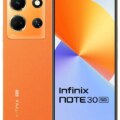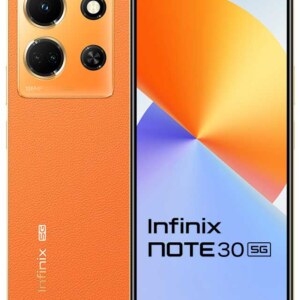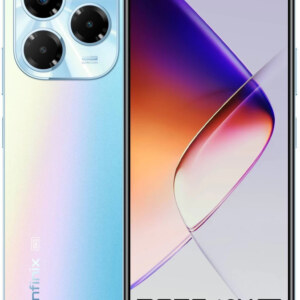- Homepage Rewise Greenshift
- 5G Mobile
- Compare
- Infinix Note 30 5G vs Note 40x 5G
Infinix Note 30 5G vs Note 40x 5G
Both the phones come from Infinix brand which has some similarities and differences.
In this comparison of Infinix Note 30 5G vs Infinix Note 40x 5G, I will list out all the things one by one in a formatted list which will make it easier for you to choose the right phone.
Hardware Spec Differences
| Infinix Note 30 5G | Infinix Note 40x 5G | |
| Launch date | May 2023 | May 2024 |
| Chipset | Mediatek Dimensity 6080 | Mediatek Dimensity 6300 |
| RAM and Storage vs Price | 4G/128G at Rs. 14999 8G/256G at Rs. 15999 | 8G/256G at Rs. 14999 12G/256G at Rs. 15999 |
| OS | XOS 13 | XOS 14 |
| Bluetooth | 5.1 | 5.2 |
| Fast charge | 45 Watts | 18 Watts |
| Audio | Hi-Res audio | Normal audio |
Hardware Spec Similarities
| Infinix Note 30 5G | Infinix Note 40x 5G | |
| Display | FHD+ 120Hz | Same |
| Camera | 108MP, 2MP, Aux lens + 8MP | Same |
| Network | 5G/4G/3G | Same |
| Battery | 5000 mAh | Same |
| Card slot | Dedicated card slot upto 1TB support | Same |
Verdict
Both these phones have several similarities and a lot of differences.
Buy Infinix Note 30 5G
The Infinix Note 30 5G has a better 45 Watts fast charging and Hi-Res audio which stands out.
If you are an audio freak you know how important and costly the Hi-Res audio hardware itself is and you know the importance of it over anything else.
If these are the most important for you on your phone, then this is the right phone for you.
Buy Infinix Note 40x 5G
On all other aspects, the Infinix Note 40x 5G is better. This includes, RAM, storage, chipset (not much but slightly better), new OS support, latest bluetooth support.
If storage and performance if your requirement, or in terms of simple words, if you take many photos, watch more videos and play games on your phone then the Infinix Note 40x 5G is the BEST for you.
General
| Device Type | 5G Mobile 5G Mobile |
| Model | X6711 X6838 |
| Announced | 22 May, 2023 05 August, 2024 |
| Released | 22 May, 2023 09 August, 2024 |
| Status | Available Available |
| Price | 14999 / 15999 14999 / 15999 |
Design
| Type Design Type called form factor refers to a mobile phone's size, shape, and style as well as the layout and position of major components of phone. There are three major form factors seen in mobile phones => bar phones, folding phones and sliding phones. | Bar Bar |
| Dimensions | 168.5 x 76.5 x 8.5 mm 168.9 x 76.5 x 8.3 mm |
| Weight | 205 gms 201 gms |
| Colors | Magic Black, Interstellar Blue, Sunset Gold Palm Blue, Lime Green, Starlit Black |
Network
| 5G Network | 1, 3, 5, 8, 28, 38, 40, 41, 77, 78 SA/NSA 1, 3, 5, 8, 28, 38, 40, 41, 77, 78 SA/NSA |
| 4G Network | 1, 3, 5, 8, 28, 38, 40, 41 1, 3, 5, 8, 28, 38, 40, 41 |
| 3G Network | HSDPA 850 / 900 / 1700(AWS) / 1900 / 2100 HSDPA 850 / 900 / 1700(AWS) / 1900 / 2100 |
| 2G Network | GSM 850 / 900 / 1800 / 1900 - SIM 1 & SIM 2 GSM 850 / 900 / 1800 / 1900 - SIM 1 & SIM 2 |
| SIM SIM (Subscriber Identity Module) is a small card that contains mobile network subscriber's account information. This allows the phone using the card to attach to a mobile network. The SIM card is most commonly associated with GSM and UMTS mobile networks. Moving a SIM card from one phone to another allows a subscriber to switch mobile phones without having to contact their mobile network carrier. SIM cards can also be used by a phone to store limited amounts of data, such as phone numbers and text messages. | Nano SIM Nano SIM |
| Dual SIM | Yes Yes |
Display
| Display Type Display Technology => A number of display technologies and types used in mobile phones => TFT (Thin Film Transistor), IPS (In-Place Switching), OLED (Organic Light Emitting Diode), AMOLED (Active-Matrix Organic Light-Emitting Diode), Super AMOLED (an even advanced version of AMOLED), Resistive Touchscreen (Resistive touchscreens contain two layer of conductive material with a very small gap between them which acts as a resistance), Capacitive Touchsceen (Capacitive touchscreen technology consists of a layer of glass coated with a transparent conductor) | LCD LCD |
| Size | 6.78inch 6.78inch |
| Resolution | 1080 x 2460 pixels 1080 x 2460 pixels |
| Display Refresh Rate | 120Hz 120Hz |
| Pixel Density Pixel Density (PPI) is refers to the concentration of pixels on a particular display, measured in pixels per inch (ppi). Pixel density is calculated by dividing the diagonal pixel resolution of a display by its diagonal size, higher pixel density better display quality. | ~395ppi ~395ppi |
| Touch Screen | Yes Yes |
| Display Protection Display Protection => Gorilla Glass is a special alkali-aluminosilicate glass shield with exceptional damage resistance that helps protect mobile displays from scratches, drops, and bumps of everyday use, It is always better to go for a smartphone with Gorilla Glass for that added protection and peace of mind. | No No |
| Features | 500nits peak brightness 500nits peak brightness |
| Secondary Display | No No |
Media
| FM Radio | Yes No |
| Headphone Jack |
Camera
| Primary Camera is able to capture photographs and usually videos, The most important characteristics of a camera are the resolution (measured in megapixels), lens focus type (fixed or automatic), higher megapixel cameras are known to capture higher quality photos, but not always a good measurement of the photos quality. | 108MP + 2MP + Aux lens 108MP + 2MP + Aux lens |
| Image | 108MP resolution 108MP resolution |
| Video | 1440p @ 30fps, 1080p @ 60fps 1440p @ 30fps, 1080p @ 60fps |
| Camera Features | AI Camera, AI Sky Shop AI Camera, AI Sky Shop |
| Flash Flash Light => There is commonly two types of flash lights are used in camera mobile phones, LED Flash (LED flash offers lower power consumption with drive circuitry that takes up very little room, LEDs can be strobed faster than any other light source), Xenon Flash (xenon flash produces an extremely intense full-spectrum white light for a very short duration) | Quad LED flash Quad LED flash |
| Secondary | 8MP, 1080p @ 30fps, Dual LED 8MP, 1080p @ 30fps, Dual LED |
Software
| Operating System OS => Every computer system run on a base software called Operating System (OS). Operating System controls all basic operations of the computer (such as smartphone, PDAs, tablet computers and other handheld devices). The Operating System allows the user to install and run third party applications (apps), apps are used to add new functionality to the device. | Android 13 Android 14 |
| User Interface UI or user interface of a device is the look and feel of the on-screen menu system. How it works, its color scheme, how it responds to button presses, all of these things are part of the user interface. | XOS 13 XOS 14 |
| OS Upgrade | 2 Years 2 Years |
| Security Update | 24 months 24 months |
Hardware
| Chipset | Mediatek Dimensity 6080 Mediatek Dimensity 6300 |
| Chipset Banchmark Chipset benchmark value | 340000 (AnTuTu score) 409000 (AnTuTu score) |
| CPU CPU (Central Processing Unit) mostly known as processors, CPU processes instructions in order to carry out certain functions that make your device operate properly. Processors are often described as the brain of computers, smartphones and tablets, Smartphones and tablets rely on processors to carry out their every task, Processors are an incredibly important factor in selecting any type of computing device, including your smartphone. | 2x 2.4 GHz – Cortex-A76 + 6 x 2 GHz – Cortex-A55 2x 2.4 GHz – Cortex-A76 + 6x 2 GHz – Cortex-A55 |
| GPU GPU (Graphics Processing Unit) is a single-chip processor designed to rapidly manipulate and alter memory to accelerate the creation of images in a frame buffer intended for output to a display, This includes things such as lighting effects, object transformations, and 3D motion. | Mali-G57 MC2 Mali-G57 MC2 |
| RAM (Memory) RAM (Random Access Memory) is a type of computer memory that can be accessed randomly, any byte of memory can be accessed without touching the preceding bytes that allows information to be stored and accessed quickly from random locations. RAM is the most common type of memory found in computer systems, smartphones, tablets and other electronic devices. | 8 GB 12 GB |
| Internal Storage Internal Storage is a data storage space (flash memory) mostly used in smartphones, tablets and other electronic devices where operating system, apps, music, photos, videos, files and other user data Is stored. | 256GB 256GB |
| Card Slot Memory Card Slot is a special slot for inserting a memory card. Memory cards allow you to expand the phone's built-in memory, A memory card (sometimes called a flash memory card or a storage card) is a small storage medium used to store data such as text, pictures, audio, and video, for use on small, portable or remote computing devices such as mobile phones, mp3 players, digital cameras. | Yes (Dedicated up to 1TB) Yes (Dedicated up to 1TB) |
| Sensors Sensors are electronic components that detects and responds to some type of input from the physical environment. The specific input could be light, heat, motion, moisture, pressure and location, The output is generally a signal that is converted to use in computing systems, a location sensor, such as a GPS receiver is able to detect current location of your electronic device. |
GPS L1CA+L5 BeiDou B1I+ B2a Glonass L1OF Galileo E1 + E5a QZSS L1CA+ L5 NavIC |
Connectivity
| Bluetooth Bluetooth is a wireless communications technology for exchanging data between mobile phones, headsets, computers and other network devices over short distances without wires, Bluetooth technology was primarily designed to support simple wireless networking of personal consumer devices. | 5.1 5.2 |
| Infrared Infrared connectivity is an old wireless technology used to connect two electronic devices. It uses a beam of infrared light to transmit information and so requires direct line of sight and operates only at close range. | |
| Wi-fi Wi-Fi is a popular wireless networking technology using radio waves to provide high-speed network connections that allows devices to communicate without cords or cables, Wi-Fi is increasingly becoming the preferred mode of internet connectivity all over the world. | Wifi 5, Dual band (2.4G and 5G) Wifi 5, Dual band (2.4G and 5G) |
| Wi-fi Hotspot | |
| USB | Type-C, OTG Support Type-C, OTG Support |
| GPS GPS The Global Positioning System is a satellite-based radio navigation system, GPS permits users to determine their position, velocity and the time 24 hours a day, in all weather, anywhere in the world, In order to locate your position, your device or GPS receiver must have a clear view of the sky. | Yes Yes |
| NFC NFC (Near field communication) is a set of standards for smartphones and similar devices to establish peer-to-peer radio communications with each other by touching them together or bringing them into proximity, usually no more than a few inches. | |
| HDMI HDMI (High-Definition Multimedia Interface) is a compact audio/video interface for transferring uncompressed video data and compressed or uncompressed digital audio data from a HDMI-compliant source device to a compatible computer monitor, video projector, digital television, or digital audio device. | |
| Wireless Charging Wireless Charging (Inductive Charging) uses an electromagnetic field to transfer energy between two objects. This is usually done with a charging station. Energy is sent through an inductive coupling to an electrical device, which can then use that energy to charge batteries or run the device. | No No |
Battery
| Battery Type Battery Type => Cell phones run on various kinds of batteries depending on the manufacturer, phone size or shape and features. There are basically four types of cell phone batteries => Lithium Polymer, Lithium Ion, Nickel Metal Hydride and Nickel Cadmium. | Li-Ion (Lithium Ion) Li-Ion (Lithium Ion) |
| Capacity Battery Capacity is a measure (typically in Amp-hr) of the charge stored by the battery, and is determined by the mass of active material contained in the battery. The battery capacity represents the maximum amount of energy that can be extracted from the battery under certain conditions. | 5000 mAh 5000 mAh |
| Charging Support | 45Watts fast charging 18Watts fast charging |
| Talk Time Talk Time is the longest time that a single battery charge will last when you are constantly talking on the phone under perfect conditions, Ambient temperature and highly dependent on the cellular network environment such as the distance to the closest cell network tower. | 16 hours 16 hours |
| Music Play | 90 hours 90 hours |


|


